Login
Subscribeglia

Astrocytes Feed Glioblastoma, Promoting Tumor Growth: Mouse Study
Patience Asanga | Oct 5, 2022 | 3 min read
Starving glioblastoma tumors of the cholesterol made by astrocytes could suppress brain cancer progression.

Bacterial Infections Disrupt Flies’ Sense of Smell
Abby Olena, PhD | Jul 21, 2021 | 4 min read
The temporary loss of olfaction stops the flies from eating any more of whatever it is that made them sick.

Exploring Stem Cell Strategies for Spinal Cord Repair
The Scientist Staff | 1 min read
In this webinar, Stephanie Willerth and Nisha Iyer will discuss the latest models that scientists use for testing the potential of endogenous and exogenous stem cell therapies for cell replacement and functional restoration following spinal cord injury.

Scientists Discover “Gorditas” and Other Novel Brain Cell Types
Amanda Heidt | Jun 10, 2021 | 5 min read
A pool of neural stem cells that ordinarily lies dormant in the brains of adult mice spawns two types of never-before-documented glial cells when artificially reactivated, potentially pointing to a novel mechanism of brain plasticity.

Michelle Gray Tracks Huntington’s in Different Brain Cells
Amanda Heidt | Oct 1, 2020 | 3 min read
The University of Alabama at Birmingham neuroscientist aims to determine which cells are most important in prompting the disease’s initiation and progression.

The Scientist's LabTalk Podcast - Episode 2
The Scientist | 1 min read
Surviving Stress: The mysteries of neuronal survival and neurodegeneration

Astrocytes, Not Just Neurons, Play a Role in Sleep
Abby Olena, PhD | Sep 24, 2020 | 4 min read
In mice, the brain’s main glial cell type exhibits distinctive patterns of activity across the sleep-wake cycle and influences the response to sleep deprivation.

Neuroscientist Phil Haydon Sets Sail to Talk About Epilepsy
Ashley Yeager | Feb 19, 2020 | 6 min read
After an accident as a teenager, he developed the disorder. He then studied the brain to better understand his own seizures, and now plans to sail around the world to show others with the condition how to push their limits.

A Common Atrial Fibrillation Procedure Is Aided by Damaging Neurons
Emma Yasinski | May 24, 2019 | 4 min read
Patients in a study of catheter ablation who showed signs of more injury to nerve cells and glia in the heart had fewer symptoms after the treatment.

Microglia Cause Cognitive Decline in Obese Mice
Diana Kwon | Sep 10, 2018 | 3 min read
The brain’s immune cells gobble up synapses in the hippocampi of rodents fed high-fat or high-sugar diets.

Reprogrammed Müller Glia Restore Vision in Mice
Ashley Yeager | Aug 15, 2018 | 4 min read
A double gene-transfer therapy transformed the non-neuronal cells into rod photoreceptors in the retinas of animal models of congenital blindness.

Glial Ties to Persistent Pain
Mark R. Hutchinson | Jan 1, 2018 | 10 min read
Immune-like cells in the central nervous system are now recognized as key participants in the creation and maintenance of persistent pain.

Sex Differences in Opioid Analgesia: A Complicated Picture
Catherine Offord | Jan 1, 2018 | 5 min read
Researchers are beginning to tease apart the mechanisms underlying differences in how males and females respond to powerful painkillers.

Infographic: Two Pain Paths Diverge in the Body
Mark R. Hutchinson | Dec 31, 2017 | 2 min read
The acute pain that results from injury or disease is very different from chronic pain.

Neuroscientist and Champion of Glia Research Dies
Kerry Grens | Dec 27, 2017 | 2 min read
Ben Barres of Stanford University described glia’s roles in ensuring neurons’ proper synapse formation and in responding to brain injury.

Image of the Day: Fly Sight
The Scientist | Sep 3, 2017 | 1 min read
In the developing Drosophila visual system, signals from glia cultivate the growth of neurons from immature cells.

Pioneering Neuroscientist Dies
Diana Kwon | Jul 31, 2017 | 2 min read
Marian Diamond, a former University of California, Berkeley, professor, discovered the first evidence for neuroplasticity and studied Einstein’s brain.

Reprogrammed Glia Improve Symptoms in a Mouse Model of Parkinson’s
Diana Kwon | Apr 10, 2017 | 3 min read
By converting glial cells into dopaminergic neurons, scientists were able to partially rescue motor behavior in mice.

Glia Help Regulate Circadian Behaviors
Diana Kwon | Mar 23, 2017 | 4 min read
Scientists confirm that astrocytes are involved in regulating molecular and behavioral circadian rhythms in mice.
